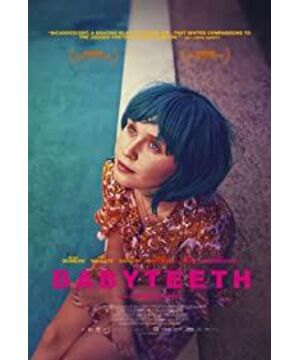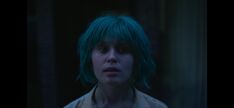Author | Cheerilee does not drive
A European and American film and television enthusiast who often forgets to check in and order takeout
In 2017, I got to know the director Shannon Murphy because of the Australian drama "Sisters" ( Sisters, 2017). The strong girl's heart has become the most memorable personal feature of "Sisters". Two years later, Shannon Murphy brings us her feature film debut, Babyteeth (2019). Two years later, Murphy not only took a step further in the quality of the images, but also presented a reflection on life and a powerful capture of the subtle dynamics of family relationships in the story, in addition to the overflowing girl's heart.
Youth on the eve of withering
Over the past decade, one category of youth stories has stood out—they focus on how teens with terminal illnesses (especially cancer) deal with newfound love in the face of death. From Josh Boone's The Fault in Our Stars ( 2014) to Alfonso Gomez-Rejon's Me and Earl And the Dying Girl ( Me and Earl and the Dying Girl, 2015), such films and novels have appeared in the audience's field of vision in large numbers. The "boy meets terminally ill girl" drama has also gradually become a form of theme, providing a different entry point for an otherwise gloomy teenage dying story.
Baby Teeth similarly focuses on the last days of a girl with cancer. So, the sweet throbbing of youthful ignorance and the tragic sadness that life is about to die in the cardamom years are mixed together. "Baby Teeth" isn't another stereotypical teenage tale of "falling in love with a bad boy." Murphy's close and delicate portrayal of the teenager's mood in a complex state also earned the film the title of the Golden Lion Award at the 76th Venice Film Festival.
The story begins when Mila, a high school student with cancer, played by Eliza Scanlen, meets a "bad boy" who is the exact opposite of her style at a small-town train station— — Moses, a 23-year-old social youth played by Toby Wallace. Like many young people on the streets of Europe and the United States, Moses resells prescription drugs, has dreadlocks, tattoos on his face, and shows a fearless look. Mira quickly fell in love with this handsome bad boy. However, the budding relationship has made Mila's overprotective parents restless. With the appearance of Moses, under the seemingly harmonious and happy shell of this ordinary middle-class family of three, the substance that is about to fall apart is displayed in front of the audience at a glance.
A hidden family crisis
Murphy did not directly tore this seemingly peaceful shell, but was very clever with his precise control of color and light, and carefully designed a series of shots to show the problems of each member of the family : Ben Mendelsohn (Ben Mendelsohn) father Henry, a psychiatrist, does not have meaningful conversations with others, only habitually prescribes psychiatric drugs to his wife and even Moses to whitewash Taiping; Essie Davis (Essie Davis) mother Anna is the most serious victim of her husband's behavior because she overuses psychoactive substances and cannot accurately reflect what is going on around her.
There are two sets of shots in the film that are very impressive. Not long after the film starts, Anna arrives at her father's clinic. The overall dim light and the dark clothes of the two made this scene surging. As soon as there was some smell of gunpowder between the words of the two, they thought of "one shot to kill the grudge". The combination of the sunlight through the large glass window and the orange light on the bookshelf undoubtedly makes this group of shots appear more layered. At the same time, the dark crisis of family strife hidden in the sun is accurately expressed.
Another set of shots is that Moses broke into Mira's house for the first time. Murphy also used light and shadow to clearly divide the whole picture into two areas - Moses was in a dim yellow light, panicked and helpless; while Anna was in the dim light. Under the incandescent light, it seemed extraordinarily dazed. On the one hand, this arrangement of light clearly shapes the instantaneous opposition between the two, and on the other hand, it also reveals a little warm color in the dark, paving the way for the subsequent plot twist.
Under the precise control of color tone and image texture, the climax of the subsequent story will naturally come naturally. As the camera continues to progress through the family, the film continues to explore the idiosyncrasies of each character, and Murphy manages to create an emotional connection with the audience in the process, which is what makes "Baby Teeth" real and brilliant.
"Girl's Diary"
However, what has to be mentioned is the narrative structure design of the film. "Baby Teeth" does not adopt the traditional film's narrative structure of "inheritance and transition" and one order to the end, but distinguishes the content of the story by "chapter titles", which has the feeling of a scattered girl's diary. This also makes the emotional resonance generated by the film's delicate excavation of characters, which is truncated from time to time and discounted.
Such "subtitles" appear fragmented, even a little coy of "stream of consciousness", which divides the whole story into finer pieces, and does not play the role of connecting different paragraphs together. "Chapter summaries" such as "Anna sees Henry on Tuesday" and "Kidong's music school" cannot convey the "central idea" of a certain passage. Comparing the four titles of "Spring, Summer, Autumn and Winter" in " La La Land " ( 2016), it uses seasonal characteristics to suggest emotional changes, and this segmentation method is excellent for dividing the film into layers.
Such a fragmented and unsystematic "diary-style catalogue" will unconsciously make the audience escape from the characters and think about the logical connection between each short segment, and by this interference, it will destroy the audience's relationship with the whole film process. The dynamics of the characters building emotional connections, ultimately resulting in a slightly raw feel.
Of course, a fair evaluation, "Baby Teeth" is still very worthy of recognition on the core. It gave the audience a lot to chew on and think about—how should we think about death? How do you view the emotional dependence in the relationship between the sexes and family? How to treat some family and social issues such as parental arrangements.
These figurative and entrenched issues in each of our lives focus on the heroine Mila, so that the young girl is no longer just a cancer-stricken, distant and fictional character, but a real flesh and blood - Mila Like many young people in this world, there is a desire to experience life in a way that has never been allowed, no matter how ill-advised the experience may seem to adults.
Although "Baby Teeth" is a little girly and eccentric to a certain extent, as Shannon Murphy said in an interview with Screen Daily : "It 's a heavy topic, but I want it to be warmer. Some". Just like a girl who loses a baby tooth, she will quietly make a wish, and then close it carefully. In the face of the approaching death and the troubles that every family can't sort out, perhaps this warmth is what we want to find more.
*This article was originally published on the cinewoo public account. repost is not allowed without consent.
View more about Babyteeth reviews











